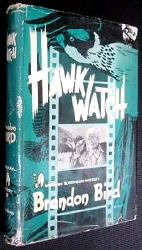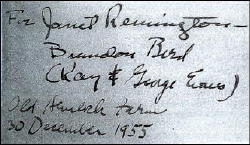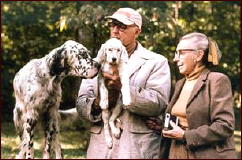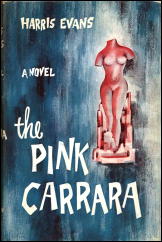Thu 4 Nov 2010
Reviewed by Walter Albert: BRANDON BIRD – Hawk Watch.
Posted by Steve under Authors , Reviews[2] Comments
BRANDON BIRD – Hawk Watch. Dodd Mead, hardcover, 1954. Hardcover reprint: Detective Book Club, 3-in-1 edition, August 1954. UK edition: T. V. Boardman, hardcover, 1955 (shown).

Kay Harris and George Bird Evans wrote four mysteries under the Brandon Bird pseudonym, but this was the first of their books I had encountered. I bought it for two reasons: it was cheap and it was signed by the authors.
Charles Gratton, a professional photographer, is on assignment in the West Virginia mountains to capture the hawk in flight. The hawk proves an elusive subject but a predatory Golden Eagle that attacks and kills a dog belonging to his local guide, and a mysterious figure Gratton catches watching him through binoculars, bring him into a situation far more daunting — and dangerous — than his hawk assignment.
This entertaining mystery makes good use of the remote rural setting, a captivating heroine, and a reclusive, canny, murderous antagonist.
Hubin lists three other mysteries by Bird, Downbeat for a Dirge, Never Wake a Dead Man, and Death in Four Colors. All three feature Hampton Hume, his wife Carmela, and Ruff, their their “faithful” English setter, Ruff.
The last recorded appearance in Hubin for the Evans’ novels is for The Pink Carrara, written under the nom de plume of Harris Evans, and published in 1960 by Dodd Mead.
My enjoyment of Hawk Watch and the intriguing titles of the three other Bird titles led me to do a bit of sleuthing on the Internet, where I came up with a number of hits for George Bird Evans.

He was born in Uniontown, Pennsylvania (a town not far from Pittsburgh) in 1906 and studied art at Carnegie Tech (now Carnegie Mellon) in Pittsburgh, where he met his future wife and co-author, Kay Harris of Wheeling, West Virginia.
After studying at the prestigious Chicago Art Institute, George (now married to Kay) moved to New York City, where he had a successful career in magazine illustration, eventually landing a contract to illustrate mystery fiction for Cosmopolitan Magazine.
In 1939, the couple left Manhattan and moved to a farm they had bought in Preston County, West Virginia, a pre-Revolutionary building they immediately began to renovate. George continued to do magazine illustrations until the 1950s, when the two, both voracious readers, began publishing their pseudonymous mysteries.
Although I’ve not been able to consult a copy of The Pink Carrera, I found a listing on ABE that described it as “a novel about a portrait sculptrist and his need to do art to support his pink carrara.” (Carrara is a city in Northern Italy famous for the white marble that was favored by Italian Renaissance sculptors.)

A signed, limited edition of all five of their novels was published as “The Old Hemlock Mysteries” in 1995. This omnibus suggests that the crime elements in The Pink Cararra are stronger than described above.
George Evans, an avid sportsman from childhood, became nationally known as a breeder of bird dogs and was a frequent contributor to Field & Stream and Pennsylvania Game News.
Late in his life, Evans apparently came to regret his contribution to overhunting that had led to a substantial decline in the numbers of native game birds, and began to lobby against the practice. After George’s death in 1998 and Kay’s in 2007, the Old Hemlock Foundation was established on their West Virginia farm with a number of objectives that include environmental protection, support of the local Humane Society, and the awarding of scholarships to the WVU Medical School.
[UPDATE] 11-07-10. Jamie Sturgeon has kindly sent me a cover image for the British edition of The Pink Carrara, along with a full description of the story, taken from the inside flap of the dust jacket:

“This is the story of a man and a woman who loved not wisely but too well. It begins in a sculptor’s studio in New York where a great conductor, Joseph Matulka, has sent his young wife Leslie for a series of sittings.
“Leslie, a brilliant opera singer; Matulka, the musical genius to whom she is married; and Paul Greer, the sculptor, are the three key figures in this situation, filled with tragedy or happiness. As the author develops his story from three points of view, the action progresses.
“A magnificent block of pink Carrara marble, which in the sculptor’s hand takes on a significance he has not realised, gradually becomes the focal point of the story and begins this serious and distinguished novel, with its suspenseful theme, to a dramatic close.”
Other than the phrase “suspenseful theme,” there is not much here to indicate that this is indeed a crime novel. We shall assume that it is, however, unless I can impose even further on Jamie to skim through the book until such time he can definitively say yea or nay.
[UPDATE #2.] 11-08-10. Here’s Jamie’s reply:
“Looking through the book there are 310 pages — the death, an accident, takes place on 276. The musical genius Matulka goes to the sculptor’s studio (with a gun) to have it out with the sculptor about the sculptor and Matulka’s wife. They have a fight and Matulka gets crushed by the pink carrara. There is some business afterwards about hiding the gun but I would say marginal at best.”
Bill Pronzini, in a separate email, has concurred. He had the book at one time and has since swapped it away. “Only marginally a crime novel,” he says, “and for my taste not half as well done as any of the Brandon Bird mysteries.”
The opinions above were duly reported to Al Hubin, who replies: “It certainly looks like it merits a dash [as having only marginal crime content] at least, if not deletion.”
His final decision on the matter will undoubtedly appear in the next installment to the online Addenda to the Revised Crime Fiction IV.
[UPDATE #3.] 11-09-10. No need to keep you waiting. He’s decided on the dash.
February 2nd, 2011 at 3:50 pm
Just got finished reading Downbeat for a Dirge. Good stuff, well written with some interesting characters and some great language.
August 25th, 2014 at 10:32 pm
I have also read Downbeat for a Dirge –enjoyed it for the musical aspects –the victim is a torch singer with a 50’s dance band –and the setting in the Ohio/Western PA/West Virginia region where I live.
I just happened to pick up a used copy of the 1953 Red Badge Detective edition, but I will look for the others. I appreciate all the information in this article.